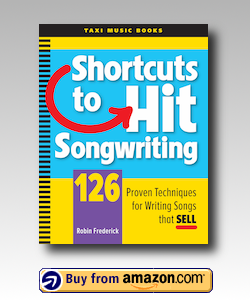‣ 3 Hot Tips from "Shortcuts to Hit Songwriting"
My books and songwriting articles are used in some of the top universities and music schools in the U.S. to teach all levels of songwriting, from beginning to advanced. Here are three useful, no-nonsense tips from "Shortcuts to Hit Songwriting" that will improve your songwriting! ~ Robin FrederickAll rights reserved. Published by TAXI Music Books. For permission to reprint, click here.
SHORTCUT #67: How to Never Write Another Cliché (excerpt)Put yourself in the scene and use what you find.A cliché is a phrase that once expressed an important truth or feeling, but through overuse has lost its emotional impact. Clichés are tempting to use because they do express something true; they never would have been used by so many writers, songwriters, and poets if they didn't.The problem is we've been exposed to them so often, we don't hear them anymore. A cliché is like an empty space in your song. Here are a few examples of clichés: "Our love is like a fairy tale." "You're always there for me." "Love is blind." Each of these lines is trying to communicate something about a relationship but we've heard them so often, they have lost any real meaning. Treat a cliché as a starting point If you write a cliché like "love is blind" don't stop there. This is a starting point not an ending point for your lyric. Ask yourself: Why do I want to say that? What is it about this relationship that suggests blindness? Then ask yourself: What are some other ways to express blindness? What happens if I explore images and feelings related to blindness, for example, darkness and light? Write down the related images and phrases that come to you: Blind = darkness, confusion, no way forward, stumbling. Try plugging these words into the cliché or using them to develop the cliché phrase, adding more interest and clarity: I'm stumbling through this love of ours. Try a twist on the cliché or extend it to say something new: "Love is blind" could become "love is a blind alley," which could lead you to a different set of images. Immerse yourself in the feeling or situation Here's another way you can avoid writing familiar, overworked phrases. Clichés happen when you take emotional shortcuts, when you write about a situation or character or event without really feeling it. Put yourself in the middle of the situation you're writing about. Don't think about it; BE in it. Imagine it as vividly as you can. Notice the small details, the sights and smells and sounds. Put those details into your song so your listeners can live it with you. Be emotionally present. Be observant. Be fearless. Be honest. And you will never write another cliché! DO IT NOW... Choose a cliché as the starting point for a chorus lyric. You can find them in greeting cards, TV shows, and magazine ads. There are even a couple of "cliché finders" on the internet. Choose a cliché and create a list of related words and ideas, twists, and extensions as described in the Shortcut. Then write a chorus lyric without using the exact wording of the cliché. |
SHORTCUT #90: Mix It Up With Long and Short Phrases (excerpt)Use a variety of phrase lengths to keep things interesting.Today's hit songwriters have figured out that breaking up melodic phrases into a variety of lengths keeps listeners interested. Often the phrases will be organized into patterns, such as two short phrases then a long one, then the pattern of phrases will be repeated. If your chorus melody consists of a series of four lines, all of the same length, your listeners may start drifting off. A melody like this can quickly become predictable. Keep them interested and guessing what will happen next by using a mix of long and short phrase lengths. ~ Try breaking up long lines by adding a pause, creating two shorter phrases. ~ Add extra words and notes at the end of a phrase, filling a pause and creating an unexpectedly long line. ~ Organize your phrases into patterns, such as two short and one long. Repeat the pattern with a different lyric. To study phrase lengths in today's hit songs, you can count along and figure out exactly how long the phrases are, but often it's easier to just listen and try to sort things out by ear. You can hear a good example on this web site. Go to the Study the Hits page and read the analysis of "Here," a No. 1 Country hit recorded by Rascal Flatts. DO IT NOW... Check out the phrase lengths in some of your own songs. If you find that your verse or chorus features phrases that are all the same length, try using the suggestions in the Shortcut to add more variety. |
SHORTCUT #14: Learn Some New Habits (excerpt)Make your songwriting habits work constructively for you.After you've written a few songs, you may notice that you tend to write similar endings for sections, or you're using the same melodic patterns over and over, or there's a particular word or phrase you always fall back on to express a certain emotion. These are songwriting habits. All songwriters have them. But that's my authentic voice! No, it's not. Your habitual choices tend to be the first things that come up for you when you're writing. Because they come so easily, they feel natural and organic. But, while the melodies or lyrics that occur to you spontaneously may feel like an authentic part of you, these are actually a result of the music that imprinted itself when you were most impressionable, usually your late teens and early twenties. This is a limited resource; there are only so many choices it can offer you. As you continue to write, it's essential that you add to this stockpile of influences and musical ideas by consciously embedding new ones. If you don't... ~ Your songs will begin to sound dated. ~ You'll stop growing as a songwriter. ~ You'll lack the flexibility needed to work professionally. Making habits work for you Songwriting habits are not bad things to have, not by any means! They're an important part of your writing process. While your song is in the early stages and you're still forming the emotional content, you don't want to be thinking about things like, "Should I use an interval jump here or start my chorus two beats earlier than expected?" That kind of question is sure to distract you from the emotions at the heart of your song. Instead, if you're continually embedding new habits and techniques based on current hit songs, you'll feel an impulse to do something new. Like all the old, outdated habits, it will just "be there," offering you an interesting, contemporary-sounding choice. So get some new habits! At first, using a new technique is something you have to consciously make yourself do. It's definitely not spontaneous. However, like riding a bicycle, the more you practice it, the more effortless it becomes. At a certain point the new technique will be something that occurs to you as a spontaneous choice while you're writing. It will be a new habit. That's the goal. To create a new habit: 1. Choose a current hit song that sounds like something you'd like to write. 2. Identify what the song is doing that appeals to you. 3. Use the hit song as a ghost song. (You can find out about using "ghost songs" in my book, Shortcut #2.) 4. Now, write a song of your own, without using a ghost song, and make an effort to use the new technique until it feels natural and comfortable. Now, it's one of the choices that will occur to you when your need it. |
Robin Frederick has written more than 500 songs for television, records, theater, and audio products. She is a former Director of A&R for Rhino Records , Executive Producer of 60 albums, and the author of "Shortcuts to Hit Songwriting" and "Shortcuts to Songwriting for Film & TV."
Robin's books are used to teach songwriting at top universities and schools in the U.S. They're fun to read and filled with practical, real world information. Buy them at Amazon.com...
Shortcuts to Hit Songwriting Shortcuts to Songwriting for Film & TV






